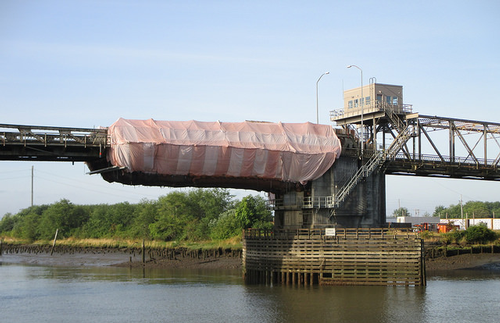THURSDAY, MARCH 16, 2017
Blasting and recoating jobs often run the risk of spreading contaminants, like lead in paint that was applied years ago. As supervisor of the Minnesota Pollution Control Agency’s Air Compliance Unit, Cory Boeck works to ensure the proper containment and disposal of potential contaminants, including on blasting sites.
Boeck, who has been with MPCA for 11 years working in enforcement and compliance in solid waste and air quality programs, spoke with PaintSquare News about proper containment practices, and common misconceptions about containment and disposal on blasting sites.
PaintSquare News: For a contractor or property owner going into a blasting and recoating job on, say, a bridge or water tank, what are the most important factors to consider in relation to whether or what kind of containment will be needed?
Boeck: If the MPCA receives a complaint in response to sandblasting, we are going to first look for two things. First: Has the material that is being sandblasted been evaluated to determine if it is hazardous (for example: lead based paint)? If it is hazardous, we want to ensure that is being properly managed and disposed of. Second: We also want to ensure that fugitive emissions are not leaving the property.

 |
| Photos: Washington State DOT, CC BY-NC-ND 2.0, via Flickr |
|
"In Minnesota there is a rule that requires, if a facility is emitting fugitive particulate emissions, they have to stay on that property," notes MPCA's Cory Boeck. |
In Minnesota, if the spent sandblast media is determined to be a non-hazardous material, then it’s classified as an industrial solid waste. If you’re generating blast media and the substrate, it must be collected and managed at a solid waste facility that is permitted to accept it.
If it’s hazardous waste, then of course it has to be manifested and handled as hazardous.
How does the blast media itself play into how materials on the site are contained and disposed of?
In Minnesota, the one thing we’ve run into from time to time is, if the sandblasting is occurring at a permanent location, the spent blast media is being used a fill material. For example, being graded into a gravel driveway, used as an aggregate substitute, filling in low-lying areas on the property. This constitutes illegal disposal, because again, it’s industrial solid waste, and has to be taken to a facility that’s permitted to take it. Properly containing the sandblasting activity ensures that cleanup is effective and efficient.
If I’m working a job that requires containment of materials and find that my containment is for whatever reason failing—there’s a hole. What should my first steps be?
Immediately cease blasting until the containment is fixed. This is especially important when working with lead-based paint or other hazardous containing materials.
 |
|
The first question MPCA will ask if it recieves a complaint about a blasting operation, Boeck says: "Has the material that is being sandblasted been evaluated to determine if it is hazardous?" |
Also, in Minnesota there is a rule that requires, if a facility is emitting fugitive particulate emissions, they have to stay on that property. Emissions are not allowed to leave the property line. That is another common complaint that we receive: Sandblasting is going on, and it’s blowing into my house, blowing onto my yard, it’s on my car. That is why it should always take place in containment.
Is there one aspect of the containment or disposal of this type of waste from a regulatory perspective that is commonly misunderstood or not realized by the contractors doing this work?
I think the big one is realizing that once the media has been utilized, it’s not classified as clean fill, and it’s not to be managed like soil or gravel. Proper containment is also important. Cleanup is easier and it greatly minimizes citizen complaints. That is why, on the front end, it’s important that before the job starts, that it gets evaluated first. That way the contractor has documentation to show the landfill that it’s not hazardous waste.
Is there anything else specific that you’d want to stress to contractors doing blasting work?
Once the project is done, all of the used, spent media, it must be collected and properly managed. If sandblasting is going to be done at a permanent location, it is the owner/operator’s responsibility to determine if an air emissions permit is required to operate.
MPCA and the Minnesota Department of Transportation offer a number of publications online as resources for contractors working field coating removal jobs, including: "Air Quality and Waste Management for the Removal of Paint on Steel Bridge Structures," "Sandblasting and Other Air-Based Blasting: Guidance for Generators of Blasting Waste," and "Facts About Removing Lead Paint from Steel Structures."
Tagged categories: Abrasive blasting; Abrasives; Blasting; Containment; Enforcement; Environmental Protection; Government; Regulations; Surface Preparation